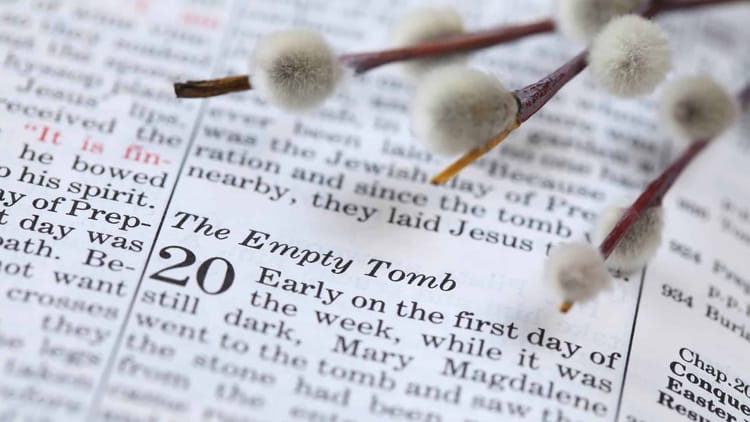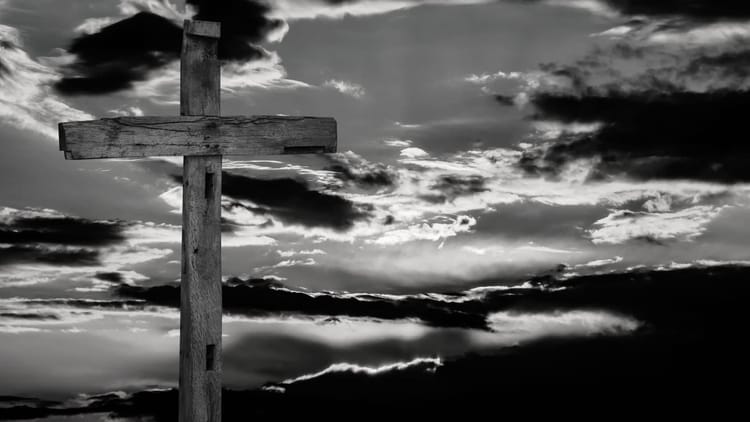Spiritual Eyesight (John 9:1-41)

Big Idea: Jesus heals a blind man, highlighting the spiritual blindness of the disciples and Pharisees, and declaring Himself as the Light of the World.
Does anyone experience selective hearing or seeing? Sure, we all do. Every second, our brain is bombarded with sensory data from all five senses. You just sat down, but already your brain has probably stopped consciously focusing on the feel of the seat. You’re probably not thinking about the temperature of the room, although you probably did at one point this morning. There are all kinds of sounds that you’re not focusing on right now – the faint hum of lights, somebody shifting beside you. Our brains would go crazy if they had to process every piece of data that our bodies sensed.
We think we’re seeing everything, but we’re all being selective all the time. Today, you’ve probably noticed who’s not here, who’s sitting in a different spot, who’s sitting with whom. You may have wondered what it means that so-and-so is sitting with that person. Years ago, before I dated Charlene, I brought a date to a function that Charlene also attended. She could tell you exactly what my date was wearing. I don’t have a clue. I never did, not even that night. It's similar with cars. You get interested in a car, and all of a sudden you notice them everywhere. They were there before, but you never noticed them.
The part of the brain that filters all this information is called the Reticular Activating System. It’s continually at work, even though we never think about it. Today's narrative revolves around our spiritual Reticular Activating System. The goal for all of us, if we’re followers of Jesus Christ, is to see the same things that he sees. We want to notice what’s important to him.
If you have a Bible with you, let’s look at the story in John 9. This is the sixth of the seven signs in the Gospel of John, and it’s the third miracle. Jesus is within about five or six months of his death. The location is Jerusalem, probably just south of the Temple area, right after the Feast of the Tabernacles. Let’s read what happened.
John 9:1-2 says, “As Jesus was walking along, he saw a man who had been blind from birth. ‘Teacher,’ his disciples asked him, ‘why was this man born blind? Was it a result of his own sins or those of his parents?'” Rabbis in that day taught, “There is no death without sin, no punishment without guilt, and there is no suffering without iniquity.” They believed that if a pregnant mother went to a pagan temple, then the unborn child would be guilty of idolatry. The disciples asked Jesus whose sin caused him to be blind, especially since he was blind from the time he was born.
The disciples saw the man as the subject of a theological discussion. That’s not what Jesus saw. Jesus saw the man as an object of mercy.
“It was not because of his sins or his parents’ sins,” Jesus answered. “He was born blind so the power of God could be seen in him. All of us must quickly carry out the tasks assigned us by the one who sent me, because there is little time left before the night falls and all work comes to an end. But while I am still here in the world, I am the light of the world.” (John 9:3-5)
Jesus saw the man’s blindness as something that could display God’s glory. What Jesus says initially looks a bit confusing, until you realize that he knew his time was limited. He saw the man, and at the same time knew that he only had five or six months left before his death. He had clarity about his mission, as well as the limited time he had left. He saw this man as somebody who fit into the mission that God gave him.
It’s like that with us when we see people. What do we notice? I have to confess that I’ve looked at people and been more interested in having a theological discussion than loving them or helping them. Part of the problem is that I think that I lack the urgency that Jesus did. I don’t really see time as short. I look at people, I look at time, and I see something completely different from what Jesus sees.
Jesus called himself “the light of the world.” There’s more there than meets the eye. Jesus had originally called himself the light of the world in John 8:12, in the middle of the Feast of Tabernacles, a feast that celebrated harvest and God’s goodness and provision. As part of the festivities, four golden lamps were put into place, and oil was poured into large golden bowls. The lamps rose over the walls of the Temple, and were so bright that they were said to light up the entire city. The Levites led the celebration with musical instruments, and the signing and dancing lasted all night. But the main candelabrum was left unlit until the last night, so that Israel would remember that their full salvation had not yet been realized. It was in the middle of this feast, with the unlit candelabrum, that Jesus said, “I am the light of the world.” He was claiming to be the fulfillment of God’s promise of salvation.
What happened next is pretty amazing. Jesus restored sight to a lot of people, but this is the only time that he restored the sight of somebody who had been born blind. Some even think that he used imagery from creation, of God forming life from dust, as he restored sight to this man. “Then he spit on the ground, made mud with the saliva, and smoothed the mud over the blind man’s eyes. He told him, ‘Go and wash in the pool of Siloam’ (Siloam means Sent). So the man went and washed, and came back seeing!” (John 9:6-7)
The man’s sight wasn’t restored right away. He was first sent to the pool of Siloam, a pool built hundreds of years before by Hezekiah to bring fresh water into Jerusalem. It was the source of water drawn out for pouring during the Feast of Tabernacles. John notes that it means Sent, and this too carries meaning – the Father sent the Son, and the Son sent the man there. It was all part of God’s mission. The pool was some distance away, and the man hadn’t received his sight yet, but he went. He obeyed. He received sight.
The man’s neighbors reacted predictably. They couldn’t believe that it was the same man. It’s the same way my neighbors would react if they saw me driving a Ferrari down the street. “Are you sure that’s Darryl? It can’t be him.” They even reported him to the Pharisees. We sort of know what to expect next.
Then they took the man to the Pharisees. Now as it happened, Jesus had healed the man on a Sabbath. The Pharisees asked the man all about it. So he told them, “He smoothed the mud over my eyes, and when it was washed away, I could see!”Some of the Pharisees said, “This man Jesus is not from God, for he is working on the Sabbath.” Others said, “But how could an ordinary sinner do such miraculous signs?” So there was a deep division of opinion among them. (John 9:13-16)
We don’t have the time to read the entire chapter, so here’s what happened. They interviewed the man. They interviewed his parents. They then cross-examined the man once again, before he told them off. Then they got really mad and threw him out – they excommunicated him. Then, Jesus tracked him down and introduced himself. The climax is verse 38: “‘Yes, Lord,’ the man said, ‘I believe!’ And he worshiped Jesus.”
Then Jesus says, “I have come to judge the world. I have come to give sight to the blind and to show those who think they see that they are blind” (John 9:39). This is when you get the idea that the story is about more than a man being given sight. It’s also a commentary on how some of the most religious people can be so very blind when it comes to seeing what Jesus sees. The disciples couldn’t see – they saw a theological discussion rather than a man in need of help. The Pharisees couldn’t see – they were conducting investigations, lives were being changed. But a blind man saw, not only physically, but spiritually. The very people you’d expect to see didn’t, and the last person you expected to see did.
It’s pretty scary to think you can see when you can’t. Jesus concludes in verse 41, “If you were blind, you wouldn’t be guilty… But you remain guilty because you claim you can see.” It’s at this point that we’re probably supposed to ask ourselves if we see what Jesus sees, or if we too think we see, but are really blind. We’re to ask if we see what Jesus sees, or whether we’re as blind as the disciples and Pharisees.
It’s probably helpful to look at what prevented the disciples and Pharisees from seeing in this story. I think that certain attitudes got in the way. The disciples had an attitude – not a bad one, at least in the conventional sense. But it did prevent them from seeing someone the same way Jesus did. I’m convinced this happens all the time in our lives as well.
We had a kid down the street from our house who unplugged our fridge one year while we were out of town. Not a happy situation for us. We lost a few hundred dollars worth of food. It’s safe to say that I developed a bad attitude against this kid. If I picked anyone that I thought God would touch, it wouldn’t be him. Despite my attitude, God has been at work in this kid’s life. My attitude got in the way of seeing him the same way that Jesus does.
Our attitudes toward people can get in the way of seeing them as Jesus does. One of my prayers is that God would allow me to see others the way that he sees them.
Sometimes beliefs get in the way too. The Pharisees were more concerned about Sabbath-breaking than they were about changed lives. That’s because they couldn’t see past their beliefs. The strange thing is that their belief wasn’t based on God’s beliefs. They had confused their rules with God’s rules. They were as concerned as we are usually with orthodoxy or right belief. Ironically, their concern for right doctrine got in the way of seeing things through the eyes of Jesus.
It’s scary, yet important, to ask if there are any beliefs that we hold to that prevent us from seeing things as Jesus does. What assumptions do we hold? I’ve found this challenging. I’ve been wrestling with different concepts of the church. There are a lot of Christians who are tired of the church – not the church as the Body of Christ, but of the church as an institution. They’re looking to be the church in a new way, which may be more like an old way. They’re meeting in houses, and instead of owning buildings and building programs and hiring preachers, they’re doing things a little differently. It’s easy to miss what God is doing in groups like this because it doesn’t fit into our belief structure. Sometimes that belief structure has nothing to do with God, but we hold to it like it does. Our beliefs can get in the way of seeing things like God does.
The scary thing is that they didn’t just miss seeing things the way that Jesus did. They missed seeing Jesus. The very Son of God was standing right in front of them, healing and doing God’s work. The people that should have been most able to see it were the most blind. A blind man saw more clearly than they did.
This miracle is about more than a blind man receiving sight. It’s about who Jesus is. He’s the light of the world. It’s about the fact that the people who should be best able to see the light are sometimes the most blind.I don’t want to miss seeing what God is doing. I don’t want to be blinded by my incorrect attitudes and beliefs. I don’t want to have Jesus act right in front of me, and yet miss it.
Prayer:
Open our eyes. Open our eyes to our incorrect attitudes and beliefs. Open our eyes to the people around us, what you’re doing in their lives.Most of all, open our eyes to Jesus.





